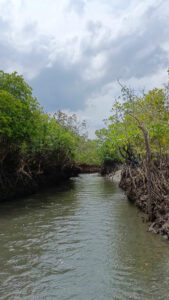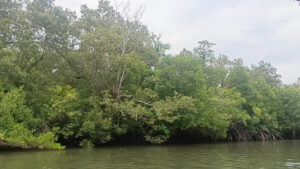by Edg Adrian A. Eva, Reporter
In Barangay Alitas in Infanta, Quezon Province, where saltwater and freshwater quietly converge, trees with roots rising from the shallows dominate the landscape. These salt-tolerant trees, known as mangroves—or bakauan in Filipino—have long sustained the community with food, protection, and resilience.
For Sherwin P. Aveno, a 36-year-old rice farmer and part-time fisherman, mangroves are more than just trees. As president of the Alitas Farmers and Fisherfolk Association Inc. (AFFAI), he believes that mangroves are a lifeline for their community.
“Mangroves help us because they become breeding grounds for fish,” Mr. Aveno said in Filipino, emphasizing the importance of mangroves to their daily catch.

Forester Thaddeus C. Martinez, Manager of the Natural Resources Management Department at Haribon Foundation, AFFAI’s partner environmental organization, told BusinessWorld that mangroves are a nature-based solution to climate change due to their ability to capture and store up to five times more carbon than terrestrial trees.
“Carbon absorption in a mangrove forest is bigger. Why? Because it’s also in the soil, the mangrove area’s capacity to sequester carbon,” Mr. Martinez said in mixed English and Filipino.
“There is more carbon stored in the soil. So, it’s a combination of the tree’s functions and the soil.”
He added that they also serve as a habitat for various species of fish and crustaceans, which provide a source of livelihood for the community.
“So, if there are no mangroves, how will they multiply? That’s one of the basics, but sometimes, many people don’t appreciate this,” Mr. Martinez said.
A 2012 report by The Environmental Law Alliance Worldwide (ELAW) shows that mangroves can significantly reduce the height of wind and swell waves by 13% to 66% over a distance of just 100 meters.
“When a typhoon hits, instead of experiencing the full force of a Signal No. 3 storm warning—which indicates destructive winds—we feel a weaker impact,” Mr. Aveno said.

Human threat
Like other wildlife, Mr. Martinez said, mangroves are also not spared from threats caused by human activity.
Mangroves are cut down to be used for furniture and other household items, or as fuel wood.
Before the restoration efforts began, Mr. Aveno said that his fellow fisherfolk were cutting down mangrove trees to create pools for fish farming.
A report from the Climate Change Commission said that the Philippines has already lost a vast portion of its mangrove forest cover over the past century.
From an estimated 450,000 hectares in 1920, mangrove coverage declined to 317,500 hectares by 1990, and further decreased to 311,400 hectares in the most recent statistics.
It added that the conservation of the remaining mangrove forests is crucial, as they play a vital role in coastal protection, biodiversity conservation, and carbon sequestration.
To reverse decades of degradation, restoration efforts are now underway—led by both local communities and corporate partners.
Manulife and Haribon’s mangrove restoration initiative
To help protect and expand the country’s mangrove forests, Manulife Philippines, the local arm of one of the world’s leading financial services providers, has launched a mangrove restoration initiative with the Haribon Foundation on May 30.
The expanded partnership aims to plant more than 15,000 mangrove seedlings across various sites in Quezon Province over the next three years.
Since 2022, they have also collaborated to plant over 21,250 native trees in the Sierra Madre mountain range.
This time, the effort has expanded to the seashore, underscoring Manulife’s Impact Agenda commitments to accelerate a sustainable future, as well as Haribon’s ‘Forest for Life’ conservation campaign.
“We will be going into the back roads and doing the seed plantation ourselves. Hopefully, with these small actions, we can create some interest and willingness to take action on these very important issues in the wider community,” Rahul Hora, President and Chief Executive Officer of Manulife Philippines, said during the launch event.
Meanwhile, Haribon Foundation’s Chief Operating Officer, Arlie Endonila, expressed her appreciation for the recent expanded partnership with Manulife.
“I’ve read through Manulife’s Impact Agenda. It is truly amazing how it aligns with Haribon’s vision and mission, especially in ensuring not only a healthy environment but also the well-being of the communities,” Ms. Endonila said.
After the launch, BusinessWorld and other media members were invited to see and be involved in the mangrove restoration project.

During that time, Haribon led the planting of over 100 seedlings in the area managed by the Alitas Farmers and Fisherfolk Association Inc. (AFFAI).
Ken Carlo Peñaflor, a forester from the Haribon Foundation, said that restoring a mangrove forest is a long and meticulous process.
Two mangrove species commonly found in the area each require specific tidal conditions to survive and flourish.
The Tall-stilt Mangrove, locally known as Bakauan-lalaki, is ideally planted in the inner or landward zones.
Meanwhile, the Asiatic Mangrove, or Loop-root Mangrove, locally called Bakauan-babae, thrives in the outer zones closer to the shore.
 Mangrove restoration process
Mangrove restoration process
Mangrove life begins in a nursery, where seedlings are nurtured in a controlled environment for 6 to 8 months to ensure they are ready for planting.
Once ready, the seedlings are planted in areas that have been denuded or damaged due to human activity or strong typhoons.
Mangroves are expected to become partially viable, or begin capturing carbon, by the time they reach the sapling stage, which is around three years old.
Mangroves typically mature between 5 to 10 years, with an overall lifespan ranging from 20 to 100 years.
Mr. Martinez gladly said that mangroves planted at sites in Alitas have a high survival rate of 85%, sometimes even reaching 92%.
He expressed optimism that the initiative will be sustainable due to the support of the community, along with Manulife’s long-term commitment.
Mr. Hora assured that Manulife’s commitment to the restoration initiative is long-term and goes beyond just planting seeds.
The company will continue to support Haribon and the community until the mangroves become viable.
Mr. Hora added that they also plan to expand the initiative to other areas of the country.
 “This is just the beginning. We want to continue working with Haribon,” Mr. Hora said.
“This is just the beginning. We want to continue working with Haribon,” Mr. Hora said.
“We will sustain our efforts because we truly believe in what we are doing. So, yes, we will also continue to focus on other areas of the country.”
For fisherman Mr. Aveno, initiatives like this are warmly welcomed by the community, as they could spark the growth of other industries, such as eco-tourism, which has already started and is providing new jobs now for the community.



